What is A/B Testing?
Marketers today are continuously working towards boosting their conversion rates using an easy, expert-recommended, and effective technique for optimization – A/B testing. Irrespective of the industry, A/B Testing is a must for any growth-driven organization. It helps you leverage your online assets (customers’ touchpoints) that can convert the highest number of web visitors with a minimal amount of effort. A part of the larger conversion rate optimization (CRO) strategy, the A/B testing Service lets you collect qualitative and quantitative data to improve actions taken by your website or page visitors across the customer life cycle with your brand or company. This A/B testing guide will take you through everything you need to know about this process, including A/B testing meaning, A/B testing in marketing, and more to make you a better CRO expert and help you make the most out of your online business.
AB Testing Definition
AB testing, also known as split testing, refers to the process of testing multiple variations of a web page to be able to find higher-performing variations and improve the page’s overall conversion rate. It is a continuous process that allows you to assess and check the variation that works better for your target audience based on strategic statistical analysis. A/B Testing is conducted by incorporating incremental changes in the web page, landing page, or mobile App to derive actionable and relatable insights that once implemented, streamline the user experience and journey and thereby improve the overall conversion rate.
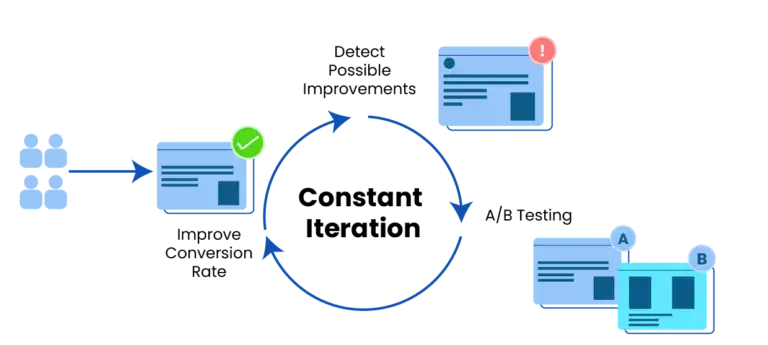
A/B testing should be ideally conducted to streamline the user journey as that is what will lead to conversion optimization. Though many organizations take a gut-driven approach to conduct A/B Testing, the conversion rate optimization experts at Tatvic take a data-driven approach to conduct A/B testing. They collect user data from reliable analytics tools like Google Analytics, and Heatmap, and craft a solid A/B testing strategy. Overall, A/B testing helps you answer important business questions, generate more revenue from the website traffic you already have, and sets the
Why Should You Do A/B Testing?
Below are some of the compelling reasons for doing A/B tests.
A. Helps You Better Understand Your Target Audience
Each webpage or website visit is unique in terms of how visitors interact with your site (expectation, intent, pain points). A/B testing allows you to better understand these elements and which of these resonate most with your target audience. This allows you to make the required changes to keep your customers happy and satisfied.
B. Reduces Bounce Rates
Users can bounce off a web page due to a variety of reasons, including a lengthy checkout process, long signup forms, vague CTAs, etc. With A/B testing, you can significantly reduce bounce rates and keep users engaged on your website. It allows you to test various versions of your page to identify the one that resolves users’ pain points and reduces friction by keeping them on the website and compelling them to convert.
C. Helps you to optimize your Marketing Spends
With A/B testing, you can easily analyze your marketing spending and identify the areas that give you the maximum returns. Besides, you can also perform A/B testing for your paid ad campaigns and save a great deal of money by scrapping or getting rid of designs or copies that do not generate any clicks or leads.
D. Allows You to Get Data-Driven Insights
A/B testing is a very data-intensive methodology with no guesswork. It allows you to test all the changes in real-time with an option to get feedback from your visitors.
A/B Testing is a valuable tool as it enables you to optimize user experiences by addressing potential drop-offs in the user journey. By systematically comparing two different versions of a particular UX element, A/B Testing allows professionals to gather insightful data on user preferences and behaviours, ultimately leading to more informed decisions regarding enhancing site design or content.
Furthermore, this data-driven approach ensures that each optimization made is backed by solid evidence, translating to increased user satisfaction and engagement.
- Further, monitoring these changes allows you to have statistically significant and reliable data. Apart from these, A/B testing also helps in:
- Increasing your conversion by helping you leverage existing web traffic
- Experimenting with various elements of an app, website, or landing page to boost conversion
- Encouraging continuous improvement in user experience
- Improving user engagement and user navigation
- Improving the checkout experience
- Getting a higher ROI (return on investment) without spending
What is A/B Testing in Marketing?
There are four different types of A/B testing that you can perform:
1. Split Testing
Split testing is a type of A/B testing where you test a completely new version of an existing page to assess and analyze the better-performing one.
The ideal time to do split testing is when you wish to test the entire design/copy of the current landing page.

When Recommended:
Wanted to implement small changes in the iteration. Split testing is recommended when you want to compare the performance of two or more variations of a webpage, ad, or campaign, and determine which one yields better results.
2. Multi-page Testing
In multi-page testing, instead of making variations to a single page, the changes made are implemented over several pages consistently to be able to find the most suitable or optimal one. This is similar to running various multivariate tests together on multiple pages across the sales funnel. When Recommended: Multipage testing, also known as funnel testing, is recommended when you want to analyze the performance of multiple pages in a user journey, such as a sign-up process or checkout flow. It’s useful for identifying bottlenecks, optimizing the entire conversion funnel, and improving overall user experience.
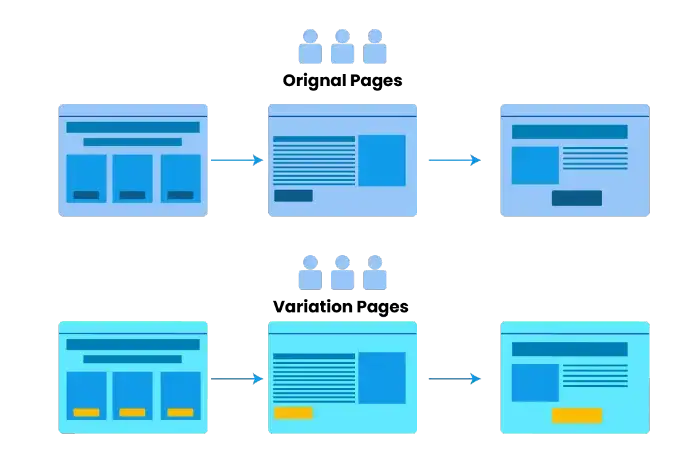
3. Redirection A/B Testing
Redirection A/B testing involves redirecting your traffic toward one or several distinct URLs. This could be an especially effective approach if you are hosting new pages on your server.

When Recommended:
Redirection A/B testing, also known as server-side testing, is recommended when you want to test major design or functionality changes that can’t be implemented using client-side A/B testing tools. It’s useful for testing complex scenarios such as server-side caching, database optimizations, and security features. Redirection testing allows you to split traffic at the server level, making it a more reliable method for testing changes that could impact site performance or user experience.
4. Multivariate Testing
Multivariate testing, or MVT, is a type of A/B testing where different variations of multiple-page variables are tested to assess and analyze the best-performing ones out of all the possible combinations.

When Recommended:
Multivariate testing is recommended when you want to test multiple variations of different elements on a web page or in a marketing campaign simultaneously to determine which combination produces the best results. Multivariate testing is particularly useful when you have a complex website or campaign that involves multiple elements such as headlines, images, buttons and calls to action. By testing multiple variations of these elements simultaneously, you can identify which combination is the most effective at achieving your goals.
What Can You Test in A/B Testing?
Multivariate testing, or MVT, is a type of A/B testing where different variations of multiple-page variables are tested to assess and analyze the best-performing ones out of all the possible combinations.
- Web page headlines
- Page layout
- Social proof
- Navigation bars
- Lead capture form length
- Page length
- Calls to action
- Pop-ups
- Media (e.g., a video vs. a GIF)
- Images (e.g., icon colors)
- Color palette (e.g., CTA colors)
While A/B Testing is typically conducted using a gut-driven approach, Tatvic takes a more data-driven approach. In addition to analyzing individual webpage elements and their impact on conversion rates, Tatvic also leverages the power of data and analytics, being a Google Premium partner it tracks user journey and behavior which allows it to pinpoint specific causes of drop-off within the conversion funnel and make more informed recommendations for optimization.
How to Determine if Your A/B Test is Statistically Significant?
There are mainly two types of A/B testing statistics to determine if your A/B test is statistically significant:
1. Frequentist Tests
The frequentist method is objective and allows you to do a proper and detailed analysis of A/B testing hypothesis results only towards the end. This is an observation-based method that gives results with an accuracy of almost 95%.
2. Bayesian tests
The Bayesian method, on the contrary, is deductive. It allows you to analyze your A/B test results before the beginning of the test. What is important to make sure of, however, is to read the interval accurately.
A/B Testing Examples: Travel Website
The travel industry often faces the challenge of high user drop-off rates in the conversion funnel. A/B testing can help identify and optimize critical elements on a travel website, such as search functionality, navigation, and booking forms.
One leading travel website wanted to set up a data-driven culture for their Product and Analytics teams to improve user experience, website conversion rate, and online sales. They sought the help of Tatvic which is a Google Optimize 360 partner to conduct A/B testing and address the underlying reason for high user drop-off, particularly on the hotel listing page.
Tatvic was able to identify the root cause of the problem through user journey analysis and feature attribution analysis. The data showed that many users were browsing the hotel listing page but not proceeding further.
To address this issue, Tatvic created a hypothesis to create a sense of urgency by showing how many users were viewing the hotel and the remaining number of rooms available. This was based on the insight that users were exiting the page without converting and possibly checking other competitors for the same hotels. The results of the A/B test were impressive, with a 30% improvement in conversion rate achieved by implementing the principles of persuasion on the hotel listing page.
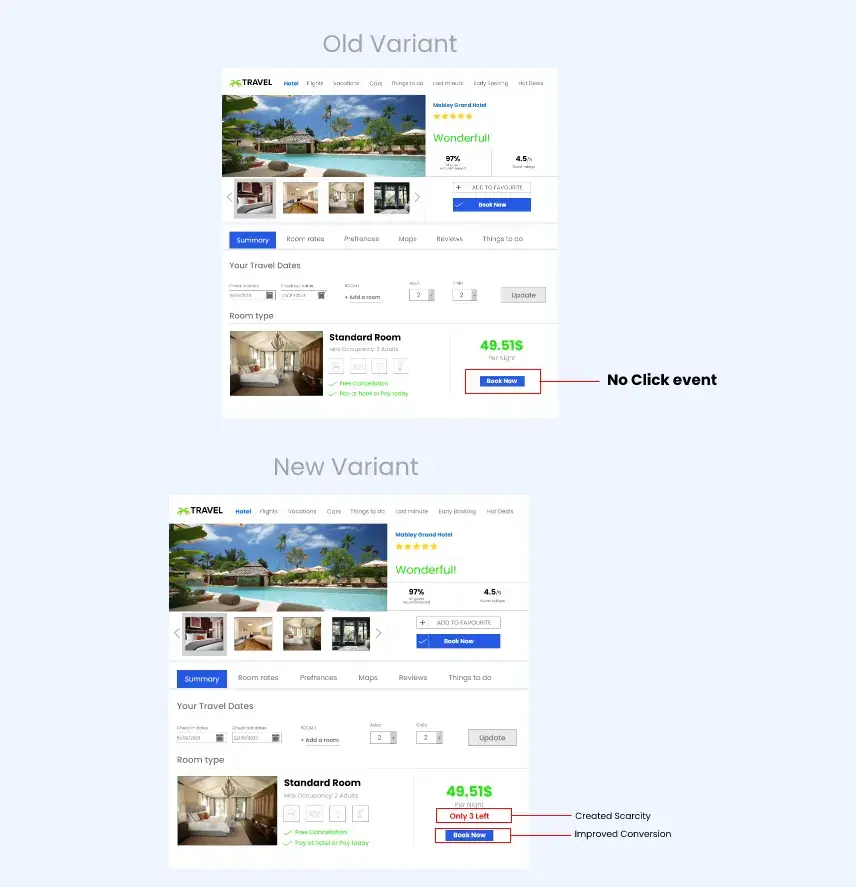
A/B Testing Examples: Online Marketplace
A large online marketplace for used cars aimed to simplify the process for customers to book appointments online, to enhance their website’s conversion rate. The key metric for success was the number of users booking appointments through the website’s form.
Tatvic, using comprehensive tracking data collected from Google Analytics, identified the problem to be with the multi-stage navigation section on the homepage.
To address this, they hypothesized that a one-page lead generation with the copy “Sell Your Used Car in 30 Minutes” and the addition of city, center, appointment date, time, and mobile number in place of email, KM, reg. state and variant would be more effective.
The A/B test results showed that the desktop variant led to a 66% increase in leads, while the mobile variant led to a 70% increase in leads, after 2 weeks.
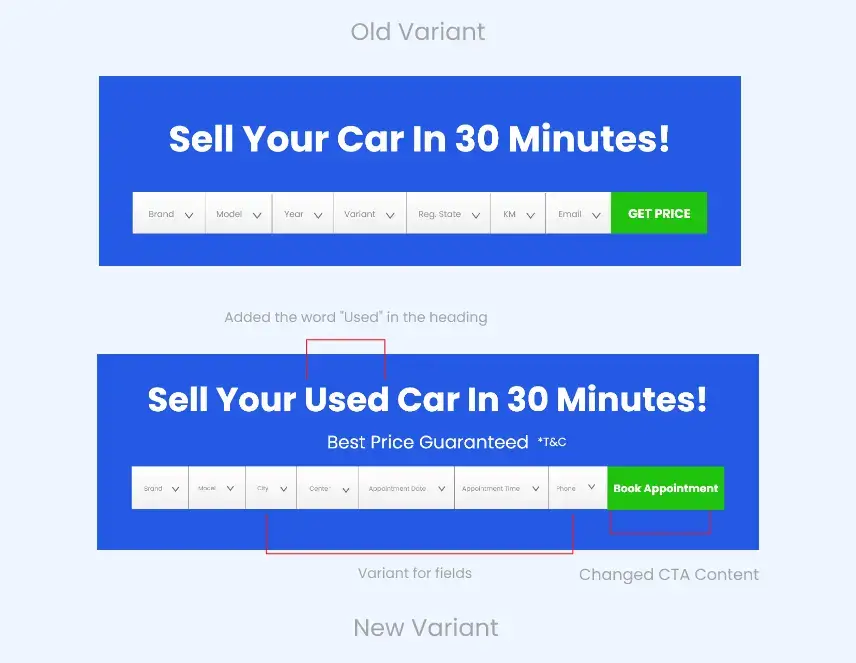
A/B Testing Example: Automobile Website
An Indian multinational motorcycle manufacturer wanted to increase the conversion rate and drive more traffic to the website’s ‘Book Test Ride’ Form by conducting a specific set of A/B tests and form-field analyses.
Tatvic analyzed the website traffic and conversion data and discovered that the Test Ride form required a redesign to improve performance.
Additionally, they identified the need to drive more traffic to the form. To address these issues, they introduced a floating Call to Action (CTA) as a variant on the homepage for all devices and created a new form design that rationalized the number of fields, reinforced the CTA, and made it more engaging to users.
The A/B test results showed a significant increase in leads after 27 days. The desktop variant led to a 93% increase in leads, while the mobile variant led to a 44% increase in leads.
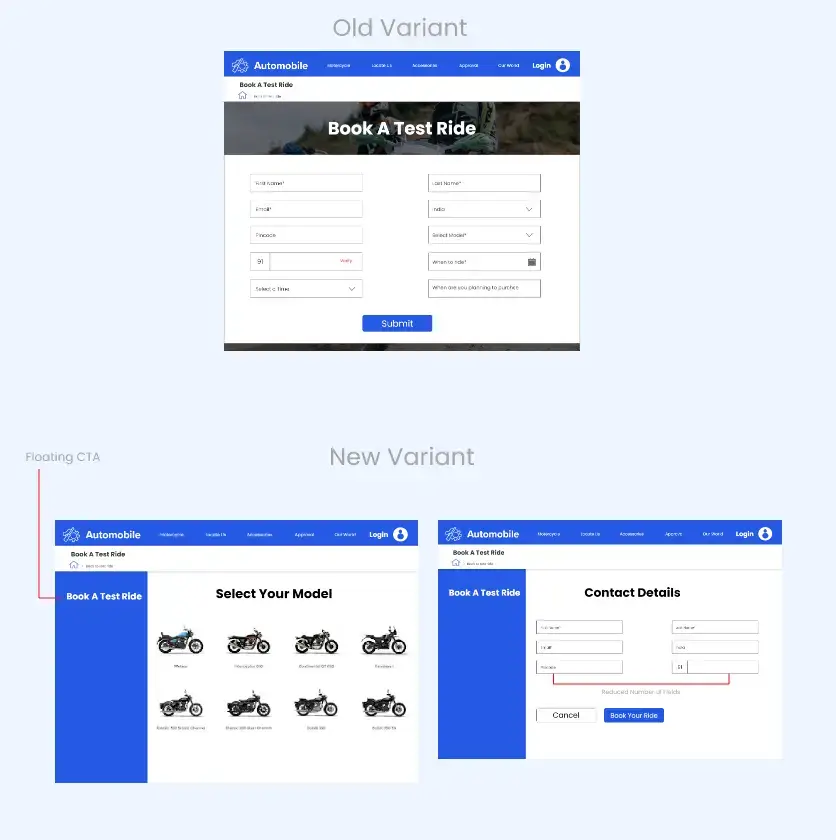
How to Conduct A/B Testing: A Stepwise Procedure
A/B Testing Example: Automobile Website
Here is a step-by-step procedure to perform A/B testing:
Do a thorough analysis of your website
The first step in the A/B testing process involves a thorough analysis of your existing website, including the design and layout, user flow, and how the other elements are performing, such as forms, CTAs, and buttons.
Brainstorm different ideas and formulate hypotheses
This step involves brainstorming, developing a list of changes you wish to test, and then coming up with a hypothesis about how these changes will impact the desired outcome.
Your A/B testing hypothesis should detail a proposed new variant of the page and why you think it will produce a better result in your next content experiment.
Design variants
Once a hypothesis is created, the next step is to produce a different variant of the same page that you will be using in your experiment.
This can be done either manually or using a CRO tool such as Google Optimize that helps streamline and automate the entire process of designing test variants of a specific page.
Run a content experiment
As soon as you have designed a variant of the page, the next step is to configure and run your content experiment. Various CRO software tools can be used to determine customization or split traffic between multiple landing page variations.
Measure and analyze your A/B test results
The final step is an A/B test result analysis to measure and analyze the results to determine their success. After this, you can use statistical methods to determine whether your hypothesis was proven correct. The entire process can be summed up below:
Divide your web traffic randomly into two or more equal groups and show them different variations of your assets for a fixed period
Compare the performance of each version in terms of metrics such as conversion rate or sales
Analyze the results to assess if the changes are worth implementing permanently
A/B Testing for Conversion Rate Optimization
a. Run A/B tests on your landing pages. Make sure to put at least two different landing pages, which are differentiated by one single element, against each other to run the A/B test. This could include different designs, CTAs, images, and copy lengths.
b. Make sure to experiment with a CTA button (including font, colour combinations, changing the wording, copy length, etc. to test your website and improve conversion.
c. Website navigation impacts user experience significantly. Make sure to test different variations of your page layout and check if it is easy for users to find what they are looking for and if it is appropriate design-wise.
What is a False Positive in A/B Testing and CRO?
A false positive, also known as a Type 1 error or false positive error in A/B testing, is an indication of whether the difference between variations was due to the alterations or other noise. A high confidence level helps prevent these false positives.
In A Nutshell
The A/B testing framework is a proven methodology that offers you detailed data-driven insights to implement and improve your conversion rate. It is a continuous process that, when followed diligently by developing an accurate hypothesis and letting the test run for adequate time, will give you several benefits.
When running an A/B test, it is critical to use a valid methodology to rely on the test results and produce better performance even after the test is completed. For marketers, A/B testing is a valuable resource that, if used properly, can help them optimize the user experience and get faster conversions.

